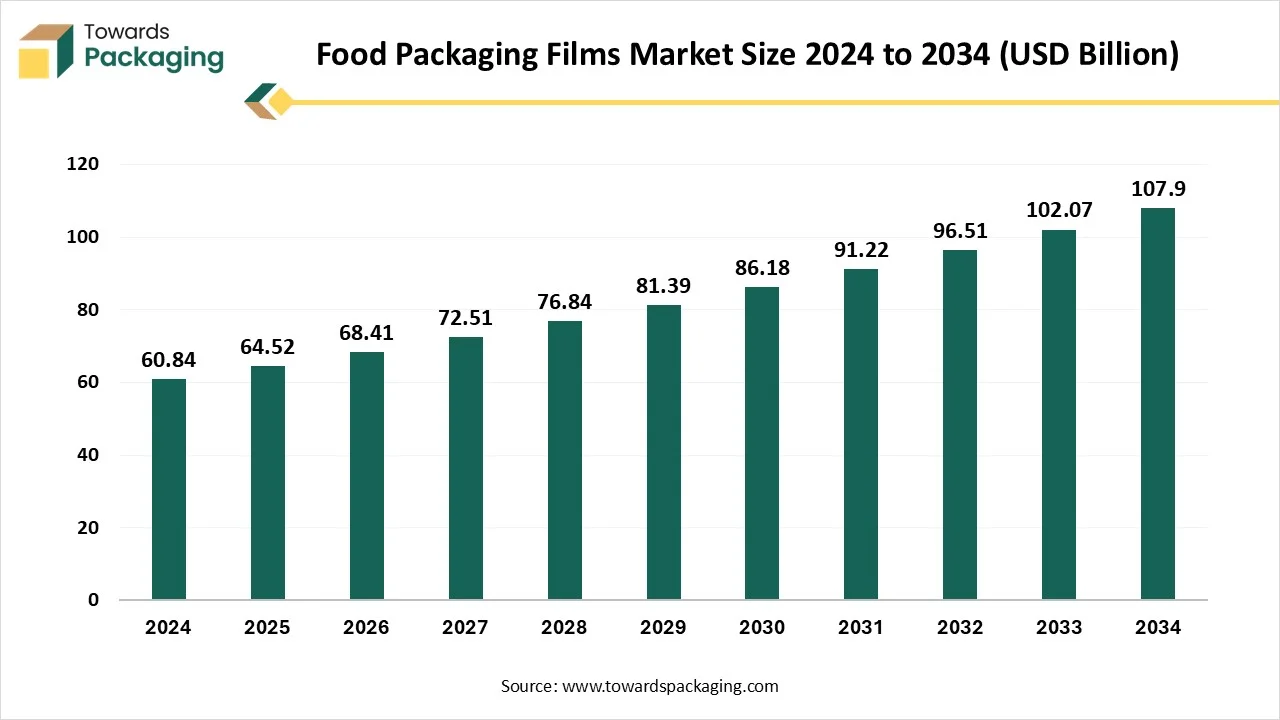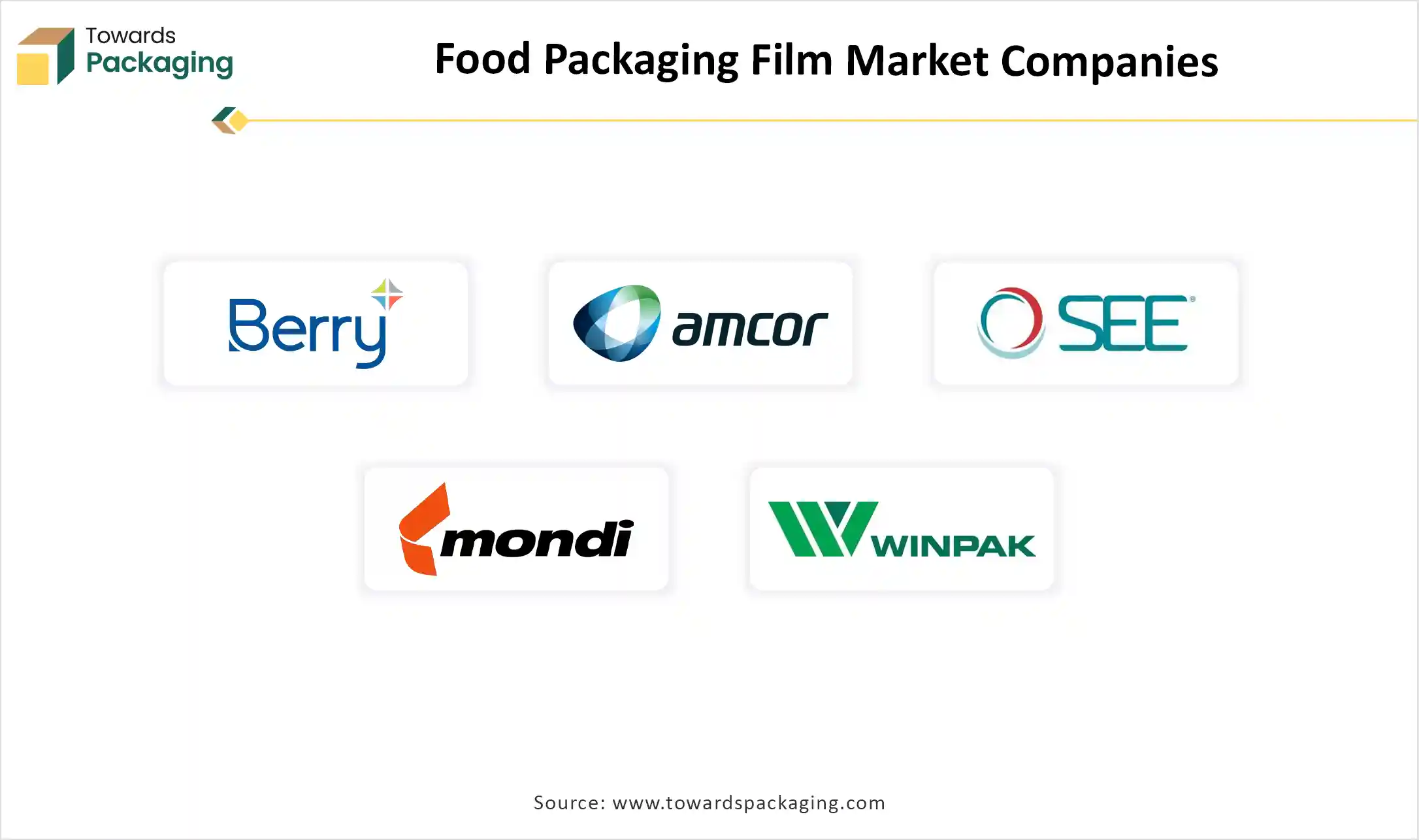November 2025
The food packaging film market is projected to reach USD 107.9 billion by 2034, growing from USD 64.52 billion in 2025, at a CAGR of 6.05% during the forecast period from 2025 to 2034. The rising food packaging industry drives this market. Various fruits, vegetables, bakery items, fish, meat, etc., are heavily using food packaging film for packaging purposes due to its high durability and effective protection.

The rising food packaging film market is the primary driving factor for the food packaging film market in the current times. Food packaging films have helped to improve the convenience and shelf life of food storage by protecting it from external exposure such as dust, moisture, and light. One of the key factors behind this growth is the growth of the e-commerce sector, which has increased rapidly in recent times. Consumer behaviour has adopted the consumption of packaged food as a part of daily life, and the instant food delivery applications have also leveraged this opportunity.
After Covid-19, the overall market has completely shifted the focus on hygiene and safety, and the government and end consumers are also becoming more aware of the safety standards for food and edibles. Fruit, vegetables, bakery products, fish, and meat products are heavily using the food packaging films because of their effective protection against moisture, which helps increase the shelf life of the product and maintains hygiene.
| Metric | Details |
| Market Size in 2024 | USD 60.84 Billion |
| Projected Market Size in 2034 | USD 107.9 Billion |
| CAGR (2025 - 2034) | 6.05% |
| Leading Region | Asia Pacific |
| Market Segmentation | By Material, By Type, By Application and By Region Covered |
| Top Key Players | Berry Global, Amcor Plc, Sealed Air Corporation, Mondi Group, Winpak Holdings Inc. |
AI Integration in food packaging films is going to be a game changer in the upcoming days it is helping in optimising the selection of materials for effective packaging. Integration of AI and IoT with smart tag sensors is going to impact the food market in a very disruptive manner as, it will improve the shelf life of the product packaging by various ways such as, by monitoring the freshness with sensors which will help to take necessary actions and precautions on the right time to avoid wastage of food items.
The automation tools, such as robots in the packaging, can help to increase the accuracy of packaging and the speed, which will help reduce the cost of packaging and achieve better quality. Based on Data Analytics, accurate decisions can be taken as it is connected with the inventory. It knows the shelf life of every particular product, so it helps the supplier to take precautionary actions at the right time, as it is not humanly possible to remember all these things and do all this work manually. Intelligent systems can help give notifications that will help optimize the strategy.
Rising Demand in the Packaged Food Industry
The global shift towards the consumption of packaged food items due to the fast-paced life and increased urbanisation is driving the food packaging film market. The rising urbanisation has increased the requirement for food products transportation from their origin places to the marketplace with proper safety and freshness. This requirement is fulfilled by food packaging films very effectively. The backbone behind the food film packaging market growth is the technological development in the food packaging film production, as it has enabled the high-quality production at an effective cost. The most crucial thing about food packaging films as they offer high-quality hygiene for the product and increased shelf life, which is driving the food packaging industry towards growth.
Challenges Regarding Waste Management and High Cost of Biodegradable Materials
The most crucial challenges currently faced by the food packaging film market are the constant volatility in the raw material prices, and various governments are continuously introducing new regulations for packaging materials worldwide due to increasing waste management and environmental concerns. Plastics are the material that is mainly used in the food packaging market due to their cost-effectiveness and durability. But the major drawback of plastic material is, it can be a very harmful material for the environment if not managed and recycled properly. Due to this government is pushing the market towards biodegradable materials, but the concern is that biodegradable materials are currently in the development stage. Their effectiveness is under observation, the cost is currently relatively high compared to plastics, and the most important thing is that the availability of biodegradable materials is very less compared to plastics in the present times. The growth is expected in the upcoming time, but the current situation of the market is that it is heavily in the transition phase, considering the materials point of view.
Rising Market for Sustainable, Effective, and Innovative Products
Rising demand for sustainable products is going to be the next thing in the food packaging film market. As the government and consumers have realised the consequences of non-degradable materials and the waste management challenges, it is pushing all companies and governments to collaborate and continuously work on the development of new innovative biodegradable products. They are continuously innovating new ways to recycle plastic and reduce carbon emissions from plastic. Plant-based biodegradable products are becoming popular, and new innovative solutions are coming to the market.
Polyethylene (PE) Dominated the Food Packaging Films Market in 2024
Polyethylene, which is a type of plastic, dominated the food packaging film market due to its high durability, cost-effectiveness, high strength, and abundance of availability, with various types of applications, which is making it the dominating food packaging film product. As a mono-material plastic, it is highly recyclable, which also makes it a popular choice. The polyethylene market is estimated at USD 118.5 billion in 2024. Polypropylene (PP) is expected to be the fastest growing material in the food packaging film market, considering its high effectiveness against moisture and water vapour, it also provides significant protection against gas and odor.
Rigid Packaging Dominating the By Type Segment in Food Packaging Film Market
Food items and beverages find it a very effective product for a protective barrier and to avoid contamination. Particularly for a product that requires long-duration storage and shelf life in exclusive conditions, the rigid packaging type is the best available solution in the food packaging film market. Flexible packaging is the fastest growing segment due to its various usage in the market for snacks, biscuits, and Bakery products, all kind of food items in the FMCG sector use the flexible packaging due to its high convenience, high durability, light weight and cost effectiveness which makes it the popular product type in the food packaging market.
The Meat, Poultry, and Seafood Packaging Segment Dominated the Global Market
Increasing consumption of meat poultry and sea food due to inclination towards healthy lifestyle and increasing awareness about the protein consumptions requirements, has increased the demand of effective packaging for these products. as these are highly perishable and environment sensitive food products required efficient packaging solutions while providing effective barriers against external environment, moisture, contamination, and water vapours while maintaining the utmost level of hygiene. Followed by this, the Food and beverage section is expected to be the fastest growing due to consumer behaviour shift. Increased packaged food consumption, technological improvement in the food preservation sciences, and easy accessibility of packaged food and beverages have made it a part of consumers' daily life.
The Asia Pacific dominated the food packaging film market due to a huge population and growing urbanization, which is leading to an increase in the packaged food items market. The technology has enabled cost-effective and highly efficient packaging solutions in the food packaging film, which has made it highly accessible in the region. This region is facing challenges and is also working actively towards solutions for waste management of the film packaging.
Sustainable solutions are being adopted, and emphasis on recycling the mono-material plastic is highly preferred in the region. China and India, containing almost half the population of the world, will continue the dominance the food packaging film market in the upcoming years.
The North American market is expected to show the highest CAGR due to increased consumption of packaged food items in this region. The rising urbanization and customer inclination towards packaged food items are the main driving factors in this region. The technological advancement is also ensuring a reduction in the cost of packaging and high-quality food packaging film solutions. The most crucial thing in this region is the demand for sustainable packaging solutions. Continuous innovation is going on for biodegradable materials and recyclable plastic materials. The effective waste management strategies by using different innovative solutions are being implemented on a huge scale throughout the region.
The European region is showing notable growth due to various applications in food preservation strategies using food packaging film, while promoting sustainable materials in the food packaging film market. Stringent government regulations are pushing companies to figure out new innovations and materials for food packaging film solutions, and also, the emphasis on recycling and circular economy is being adopted heavily in this region to reduce the generated waste.

By Material
By Type
By Application
By Region Covered
November 2025
November 2025
November 2025
November 2025